A Rhetorical Analysis: The Lutheran Immigration and Refugee Service
Introduction
Nowadays, various forms of texts will usually have subliminal messages within them that require further thought in order to unbox the true purpose and intention of an author. A rhetorical analysis of a piece of text is a beneficial and effective method in identifying the ideas an author wants to communicate. Writer/Designer: A Guide to Making Multimodal Projects describes five areas that help determine the author’s purpose which is: author, audience, genre, context, and purpose; and five modes that aid in communicating the message such as: visual, linguistic, aural, spatial, and gestural (Arola, Sheppard, Ball 22). I will be analyzing each of the five areas as well as the various modes and how they contribute to the success of the Lutheran Immigration and Refugee Service (LIRS) website.
Author
Who is LIRS? It’s easy to determine the mission and purpose of non-profit organizations just by clicking their “About Us” page, but what makes the organization credible? Deeper into the “About Us” page lists the leaders of the organization. While the Chief Executive Officer, Pat Nichols, is currently the person leading the organization towards accomplishing its mission. The LIRS website posted a short article about his past experience which makes the website visitor more inclined to donate if they knew the person is trustworthy.

The other important contributor to the success and reputation of LIRS is Danielle Bernard, the Director of Marketing and Communications. Although Ms. Bernard isn’t directly involved in the creation of the website, she is responsible for maintaining the organization’s public image, which includes how they are represented on their website. The website is multimodal, with a greater concentration on the visual, linguistic, and spatial modes. Visually, the layout of the website is minimalistic. 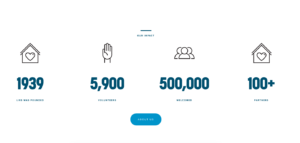 It is easy to conclude which information provided are important based on the sizes of the fonts and which information they want to emphasize. Instead of writing out “Since 1939, over 5,900 volunteers and over 100 partners, we have helped welcome 500,000 immigrants, asylum seekers, and refugees,” simple figures and large numbers were more effective and visually appealing to the viewer.
It is easy to conclude which information provided are important based on the sizes of the fonts and which information they want to emphasize. Instead of writing out “Since 1939, over 5,900 volunteers and over 100 partners, we have helped welcome 500,000 immigrants, asylum seekers, and refugees,” simple figures and large numbers were more effective and visually appealing to the viewer. 
Spatially, the website is designed very well. Starting from the homepage, the facts, texts, and images blend well together and doesn’t strain the visitor’s eyes when scrolling. All of the information in the website are organized accordingly based on their topic. The menu tab is listed on the top of the page. The gestural mode found in the website is mainly from the arrows pointing down from the menu tabs, which also coincides with the spatial mode because of the organizational pattern of the website. There was a video on the website found within the “Take Action” tab under the “Volunteer” and “Detention Visitation” which aligns with the aural mode, however, most of the website is text and visual therefore the audience will be navigating in silence. Linguistically, the text throughout the website is short, concise, formal, yet coherent. The texts doesn’t require a high level of vocabulary and doesn’t take too much time to read. The author is very clear with their intentions and purpose.
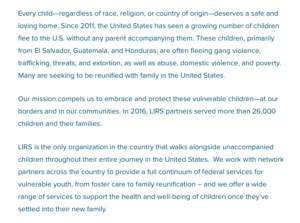
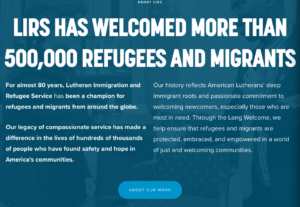
Audience
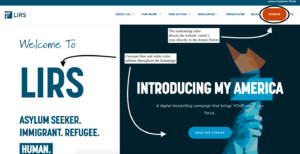 The first step in determining an author’s true purpose is to analyze the intended
The first step in determining an author’s true purpose is to analyze the intended
audience. It is evident that the primary audience of the Lutheran Immigration and Refugee Service (LIRS) website are donors. The website designer intended the entire website to be a simple color scheme, with mostly white and blue text, but the designer purposefully created the “DONATE” button to be in contrast with the rest of the homepage with a bright red bubble around it.The secondary audience of the LIRS website are Lutheran church members and political activists whose focus is on immigration. The entire organization was founded by the Lutheran Churches throughout the United States and the focus of the entire organization is to aid in the transitions of migrants fleeing their homes which has been a political issue many countries face to this day.
Genre
The LIRS website is classified as a non-profit organization. According to the article What is a Nonprofit? nonprofit organizations serves public interests and generate profit to further their cause, not to harvest income (Brownsword, et al What is a Nonprofit). With that being said, nonprofit organizations have to be transparent and open to share where the money generated goes. For LIRS, it can be implied that donations are one of their sources to financially support the organization and the people they help. It is imperative for the intended audience, the donors, where the money goes. LIRS offers a PDF file for their annual financial statements which dates back to as far as 2013. The author of the website provided a pie chart to visually show how much money is directed to the programs they offer, management, and fundraising. This amount of transparency between the donor and the organization builds trust between two parties and improves the credibility of the organization and the mission LIRS is trying to achieve. 
Context
As society become more connected through technological advancements, creating a website is the most efficient way to reach a broader audience. According to the International Telecommunication Union, approximately 3.9 billion people around the world have access to the internet (ITU, Statistics). With that many people with the ability to access LIRS, they are able to successfully advocate for their cause, raise the necessary funds, and evangelize and spread their religious beliefs everywhere in the world. The organization isn’t limited to members of the Lutheran church. The website is accessible through various mediums including mobile phones, laptops, computers, and tablets. This fluidity in accessibility allows anyone at any time of day to visit the website, learn more about the organization, and possibly donate to the cause.
Purpose
So, what is the author’s purpose for the LIRS website? The first thought that came into my mind was to assist immigrants, asylum seekers, and refugees resettle in the United States. As soon as you visit the website, the website designer 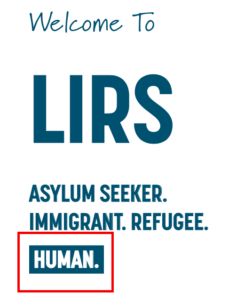
strategically provided a visual and linguistic mode that captivates the visitor and encourages them to continue to learn more about the website, hoping that the information provided will accrue donations. Starting from the homepage, large bolded words quickly draws eyes to the word “HUMAN” as a singular description for the words “Asylum seeker. Immigrant. Refugee.” After further analysis of the website and the content provided, the overall intention was to gather donations to fund the resettlement of the migrants as well as the programs offered by LIRS.
Conclusion
The Lutheran Immigration and Refugee Service is an excellent example of a well-designed website the hasn’t lost its integrity on their path to achieving their mission and purpose. The website itself is great in integrating the user and welcoming them to the organization. The contents of the website answers questions that the visitor has yet to ask in a short and clear way. It’s easy and efficient to navigate around. The organization appears more credible and reliable due to its appearance on a computer and the information isn’t overwhelming to the audience. However, the more I navigate around the website, I’m left asking myself “where’s the rest of the information?” While minimalistic appearance and information can be more inviting, the website lacks specificity. The small links within the texts could be placed on a separate tab on the menu bar. For a random visitor to come across the site, they won’t be able to fully into the website unless they spend time clicking through every link. Overall, the website does a great job at presenting itself and its values through the website and applying the various modes of communication.
References
Arola, Sheppard, & Ball. Writer/Designer: A Guide to Making Multimodal Projects. Boston, Bedford/St. Martin’s, 2014.
Brownsword, Tracey, et al. “What Is a Nonprofit Organization?” Fit Small Business, Fit Small Business, 1 Feb. 2019, fitsmallbusiness.com/nonprofit-organization/.
ITU Contributors. Statistics. Accessed 2018. Retrieved from www.itu.int/en/ITU-D/Statistics/Pages/stat/default.aspx